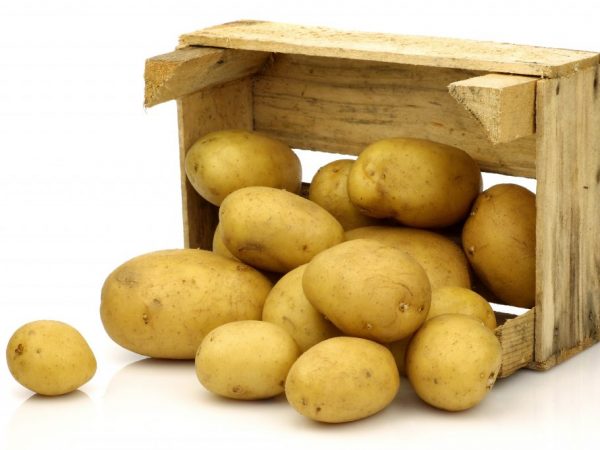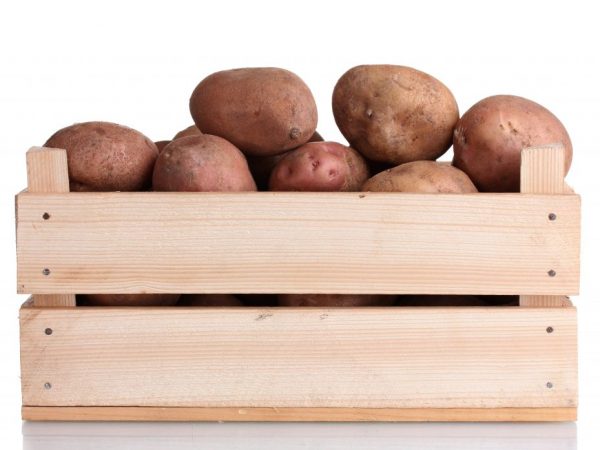Storing potatoes on the balcony in winter
It is difficult to find a person who would not stock up on potatoes for the winter. In order for the vegetable to retain its taste and attractive appearance, it must be stored under certain conditions. Consider how to store potatoes on the balcony.

Storing potatoes on the balcony in winter
Storage conditions for potatoes
In order to prevent the potatoes from freezing or rotting, you need to know under what conditions this vegetable is stored. Let's focus on the main points.
- Temperature conditions. First of all, you need to know at how many degrees the potatoes freeze. Any subzero temperature is unacceptable for him. The optimum storage temperature is 4 ° C. Deviations of 1-2 ° C are allowed, but no more. If the temperature drops below 2 ° C, the vegetable will freeze, which will affect not only the taste, but also the shelf life. The vegetable will start to spoil faster. If the temperature rises above 6 ° C, the potatoes will begin to shrink. This will negatively affect its taste, and the appearance will become unattractive.
- Humidity level. This indicator is no less important than the air temperature. For storing potatoes, the optimum air humidity is 40%. As with the temperature regime, small fluctuations in both directions are allowed here.
- Air exchange. It is important to create storage conditions under which air will flow to the tubers. The room should be ventilated from time to time. In the absence of air circulation, vegetables quickly rot.
- Shine. Any light is undesirable. When exposed to sunlight or light from an artificial source, the sides of the potato turn green. At the same time, a certain substance is produced that makes the product harmful. You cannot eat such potatoes. If electric bulbs are used to heat the balcony, they should be covered with any material through which light does not penetrate. Alternatively, cover the potatoes with a dark cloth while heating.
Preparing potatoes
Before storing potatoes on the balcony in winter, they need to be properly prepared. Vegetables are especially carefully prepared for long-term storage. Not all potato varieties are designed to be stored on the balcony for a long time in winter, so before growing vegetables, it is important to find out which varieties are capable of lying for several months.
Drying potatoes
Preparation begins at the time of harvest. Ripe tubers are harvested in dry and warm weather. To protect the crop from all sorts of diseases, it is well dried. It is advisable to dry the potatoes outdoors, but autumn weather is not always predictable.
If the rainy season has begun, you can dry the crop in any utility room, garage or under a shed, after placing it on a tarp or an old blanket. Drying vegetables on bare concrete is not recommended. If drying takes place indoors, it is advisable to leave the door open for a day.
The drying process takes 10-14 days.
We sort the fruits
The next step is sorting. The tubers are sorted according to their size. Another sorting parameter is quality. Tubers cut or damaged by pests are used first. Whatever conditions are created, such a crop will not last long. It is impossible to store damaged and healthy crops in one container.
Preparing containers for storage
At this stage, you need to decide on the container for storage. These can be bags, boxes or boxes. It is recommended to store the crop in boxes. It is more difficult to ensure normal air exchange in bags, and it is more convenient to pick vegetables from boxes than from bags.
First of all, the boxes are disinfected. This should be done regardless of whether the boxes were previously in use or not. There is no need to purchase special disinfectants. You can use a mixture prepared with your own hands, which includes soap, soda and water. If we are talking about wooden boxes, then while they dry out, they are additionally treated with copper sulfate and lime diluted in water. Copper sulfate is diluted in a ratio of 10: 1 (10 g of powder per 1 liter of liquid).
In addition to wooden boxes, you can use plastic containers or a heating cabinet. Some craftsmen are converting an old refrigerator into a potato storage. Alternatively, you can store your crops in a cardboard box in winter.
Putting potatoes in boxes
When stacking potatoes in boxes, there are some tricks that help extend the storage period. The potatoes are laid out in rows, sprinkling each row with dry straw. This improves air exchange and prevents the tubers from fogging up, which contributes to rotting vegetables. Sawdust is an alternative to straw.

The shelf life of potatoes can be increased
There is one more little trick that can protect vegetables from rotting. Putting potatoes in boxes, sprinkle them with pre-peeled and chopped garlic. Rowan leaves are an alternative to garlic.
Making a storage for potatoes yourself
A box for potatoes on the balcony can be made by hand. The advantage of a homemade box is the size of the container that is optimally matched to the parameters of the balcony. You can make it from scrap materials.
The best way to make a box is from boards. If the balcony is not insulated, it is advisable to equip the drawer with low legs or install an additional shelf on top of the bottom. The lower shelf is installed at a distance of 5-7 cm from the bottom. It is advisable to make it removable. It is inconvenient to use it as a storage space, but it will be easier to disinfect the box.
To keep potatoes on the balcony not a hassle, a box made with your own hands should be insulated. Foam is used as insulation. It is laid along all the side walls of a homemade box, foil is laid on top. It prevents damage to the foam and is a thermal insulation material. The resulting structure can be safely called a miniature cellar or wardrobe.
At the end, they construct and attach a lid with the help of hinges, which, like the entire cabinet, should be insulated with foam and foil.
Depending on the configuration, the vegetable storage cabinet is made horizontal or vertical. Such a vegetable cabinet can also be put in an apartment, but in this case it is highly likely that the vegetables will dry out.
Additional heating
It is more difficult to store potatoes on an unheated balcony in winter than in an apartment. You won't be able to get by with a do-it-yourself vegetable cabinet. Crop in severe frost freezes in it. It is best to insulate a balcony or loggia or build a heated container.
To build such a container, you will need 2 boxes of different sizes. At the bottom of the larger box, place a stand for the smaller box. The easiest way is to put wooden blocks of the right size. The boxes are stacked into each other so that there are equal gaps between all the walls.
Insulation is placed in the gaps between the walls of the boxes. Sawdust, foam, corrugated cardboard or rags are used as insulation. Any heating element is installed in the gap formed between the bottom of the larger and smaller boxes, after which the lid is erected.
A conventional incandescent lamp can be used as a heating element. It is installed between the side walls of the boxes. Insulation is placed in the space between the bottom of the larger and smaller boxes. You can also use a heating cable, as in the "warm floor" design. If desired, a homemade box is equipped with a thermostat.
A similar design can be made from an old refrigerator. In this case, the task is simplified, since thermal insulation has already been laid between the walls of the refrigerator. A thermostat is installed in the lower section, which is usually intended for storing vegetables. The construction is ready.
Another option is a balcony cellar offered on the market. It protects crops even at temperatures as low as -40 ° C. Such a balcony cellar is expensive, and it requires connection to the electrical network, so additional electricity costs will have to be taken into account.
Storage tips
When thinking about how to store potatoes on the balcony in winter, they take into account a number of factors. Before the construction of any structure, it is estimated what size it should be: the surplus will have to be stored in an apartment or on a cold unheated balcony.
If it is not possible to build an insulated box, then you can get by with several boards and a cotton blanket. Planks are installed on any hill, potatoes are laid on them and covered with a cotton blanket. Frost is not terrible for a vegetable under a cotton blanket. In addition, you don't have to spend money on such an impromptu cellar. This method works only on an insulated loggia.
If the balcony is insulated, you should not build a heated structure. Frost will not damage crops stored in insulated boxes.
Conclusion
We examined how to keep potatoes on the balcony in winter, each of the proposed options has its own advantages and disadvantages. So, for example, storage facilities with additional heating require certain material costs during construction. Potatoes do not freeze in them even on unheated balconies. On insulated loggias and balconies, it is more expedient to use structures not equipped with additional heating, the construction of which is not associated with significant material costs.


